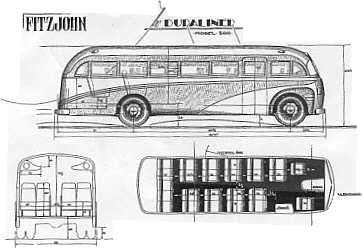
| A stylized conception of the model. 500 Duraliner, a drawing typical of the work that James J. St. Croix did for FitzJohn during the Streamlined Age. |
|
Falcon). The 500, a 24 to 32-passenger parlor bus with a Chevrolet or Hercules engine mounted over the front axle, garnered 243 sales between 1939 and 1945, when it was finally replaced by the 510 Duraliner. The 600's Hercules or Waukesha motor was installed behind the front axle, where it was practically inconspicuous and gave the bus a low-slung look. But this location turned out to be a maintenance nuisance, and as early as 1940 the model 610 Falcon joined the line. This bus was built like the 500, with its engine over the axle; an air-conditioned version was called the 615.
The War Emergency When the United States entered World War II, FitzJohn, along with all other bus builders, was given a production quota by the War Production Board. Building buses was not considered an essential wartime industry, however, and most manufacturers had their plants taken over by the government and used to build airplanes and other war material. But the FitzJohn plant was spared. Its experience at building hundreds of model 100 stretchouts and the large number of sedans that were available for conversion brought the WPB to assign to the factory the task of constructing such vehicles.
FitzJohn's wartime output consisted for the most part of 15-passenger Chevrolet sedan stretchouts with back-to~back seats and a fleet of converted auto-hauling trailers with wooden bodies to carry war workers to their jobs.
|
|
15